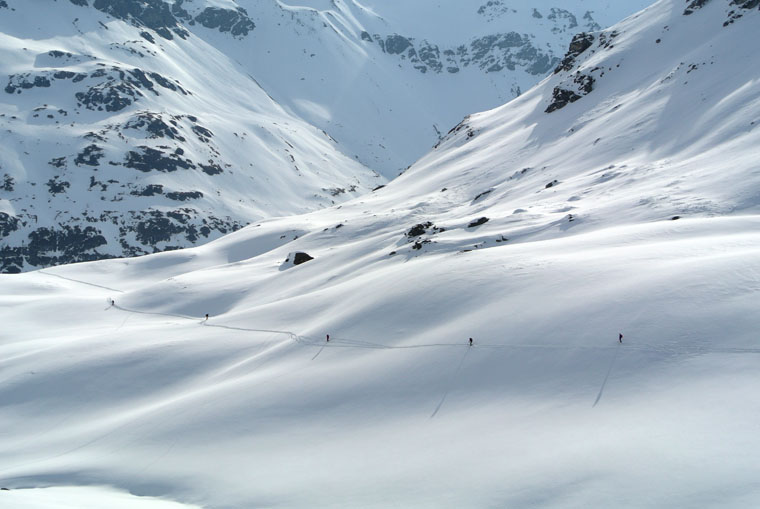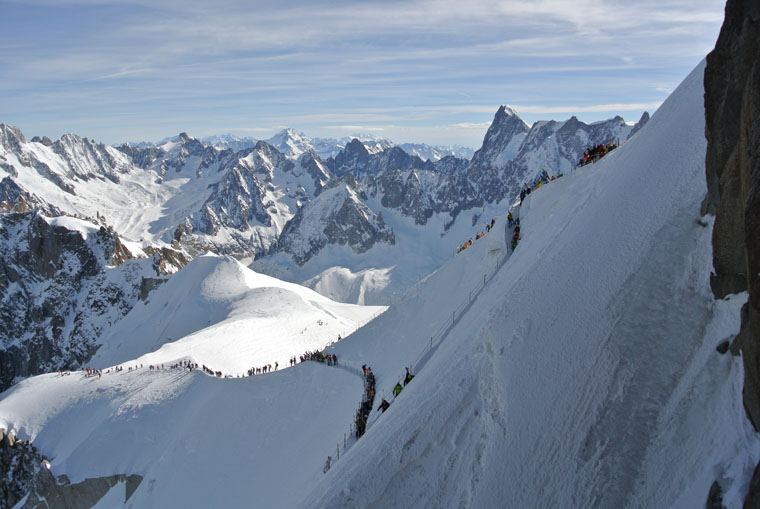8 HAUTE ROUTE TIPS
It’s the classic: a 120km ski tour from Chamonix to Zermatt. Backcountry editor Martin Chester shares his tops tips for maximum enjoyment, from what you should pack to when you should go
It is the one classic ski tour that everyone has heard of, and for good reason. But this popular journey is often overcrowded, people’s plans are often over ambitious, and for some, they will finish their trip thinking it was entirely overrated (if they complete it at all). But there are other ways to complete this iconic journey, and find out just why the Haute Route endures as the number one ski touring adventure. Here are my 8 tips for the Haute Route.
1. Cut your teeth elsewhere first
I am always staggered how many folks set out on the Haute Route as their first ski tour. The Col du Chardonnet, with an angry mob queuing up behind you, is no place to learn how to abseil! Don’t put yourself under that pressure. Go easy on yourself: fall in love with ski touring away from the crowds, and learn the skills you need in relative calm. When you finally take on the Haute Route, you will enjoy it so much more.
2. Get fit
Not only is the Haute Route a long and strenuous journey, it is (ahem) quite high! This means you are going to be dealing with altitude as well as the physical exertion and demands of the journey. The answer is to get fit well in advance. Do all the aerobic exercise you can (cycling is perfect, and easier on the knees than running), do it weeks in advance, and try to do some strength and conditioning as well. Programmes like the SkiFit app are great to strengthen joints and keep you injury free (as well as able to talk as you go).
3. Pack light
Not so much ‘every little helps’ as much as ‘every little soon adds up’! You really don’t need the huge wash kit, the seven pairs of socks, the family-size bottle of sun-cream. Work as a team and take one of anything you can share between you. You will be amazed how much more you will enjoy the climbing with less weight in your pack.
4. Respect the mountains
The Haute Route is a spectacular mountaineering journey, but it takes you through some wild and serious terrain. Make sure you have the kit and skills to be self-sufficient, and not just fall into following the herd. When it comes to travelling in avalanche terrain, there is no such thing as ‘safety in numbers’. The glaciers, crevasses and steeps along the way are no less serious for being more regularly travelled, so treat them with respect for being the untamed mountains they are.

5. Book huts early
Nothing arouses the wrath of a hut guardian more than people turning up unannounced, expecting to be fed and housed. Book huts in plenty of time, and let the guardian know if your plans alter. They live in the mountains, so they know things can change, and will be understanding. What they find hard to understand is folks turning up unexpectedly, when there is no food left to feed them!
6. Take your time
Like all good journeys this is an adventure – so the outcome is uncertain right up to the end. There will be kit failure, adversity, bad weather and worse, but you can take it in your stride if you give yourself time. That way, if the weather gods are smiling on you, and it all goes to plan, you can invest the extra days in some summits along the way, or extend the trip into Saas Fee at the end. Plenty of time takes off plenty of pressure, and makes it so much easier to make safe and good decisions en route.
7. Dodge the crowds
The huts are generally open mid-March to May. The vast majority of teams set out at the weekend – which makes for busy hut nights every step of the way. If you get out of sync with the masses, you will be pleasantly surprised how quiet it will be. My favourite trick is to warm up in Chamonix for a couple of days’ skiing (and acclimatising to altitude) then setting off on a Tuesday. Go early enough in the season, and you will be amazed what a difference a day makes! You will have busy hut nights at the weekend for sure, but there is a good chance you might get the rest of the route to yourselves.

8. Go with a guide
For some, the rewards of independent achievement cannot be underestimated. But if you fancy (a) ironing out any doubt when the going gets tough; (b) perfect timings to get the best snow conditions on the descents; (c) slick decision making to save effort for when you need it most; and (d) a whole plethora of top tips and factoids along the route; then consider taking a guide. Visit bmg.org.uk for more info.


